THANK YOU FOR SUBSCRIBING
THANK YOU FOR SUBSCRIBING

By
Logistics Transportation Review | Friday, January 27, 2023
Stay ahead of the industry with exclusive feature stories on the top companies, expert insights and the latest news delivered straight to your inbox. Subscribe today.
Last-mile deliveries are often the most challenging for the supply chain management.
FREMONT, CA: Many logistics firms concur that the last-mile delivery procedure is one of the more inefficient parts of the supply chain. Improving the last-mile delivery procedure is one of the necessary conditions for guaranteeing client loyalty when we discuss the shipping logistics of the online retail industry. The last mile of delivery occurs when a package is brought to the customer's door.
Last-mile shipment visibility is only possible with a compressive solution: Numerous logistics firms concur that the last-mile delivery procedure is one of the more inefficient parts of the supply chain.
We can now go through the last-mile delivery issues that are more pressing, considering how to overcome them so that an online store has a competitive advantage. Last-mile delivery services must prioritize timely delivery, speed, and accuracy.
Supply and demand never match existing last-mile capacity: The unpredictability of port unloading or detention times, customs holdups, highway closures, accidents, bad weather, and more may derail even the most meticulous last-mile delivery plans. A simple flat tire may affect a tight timetable when every second counts.
Shippers take the blame for faulty deliveries: Mainer times, the cause of shipment delay, loss, or damage in the products. Customers blame the shipper, costumer will not repeat the order with the same shipper, and the shipper loses crucial repeat business.
The holistic solution for this problem is to have a personal touch to alleviate problematic shipments. The technology monitors the load.
Most last-mile systems fail to account for returns: Shippers' last-mile systems should be considered extensions of their customer service operations. Keeping track of customer returns is crucial, and a good customer experience includes a smooth returns process.
Shippers that ease the returns process for their customers have a leg up on the competition. Other things being equal, customers are likely to do business with vendors that pick up their returns directly rather than requiring the customer to deliver the return to a shipper or carrier location.
The last mile represents the costliest leg of the delivery process: Comprehensive last-mile delivery solutions can perform other magic as well, such as holding orders in the system for a short time in case the customer places another, optimizing internal delivery fleets by removing shipments that take drivers off the beaten track and allowing shippers to promise next-day delivery at second-day rates when shipments move within the same zone.
I agree We use cookies on this website to enhance your user experience. By clicking any link on this page you are giving your consent for us to set cookies. More info





